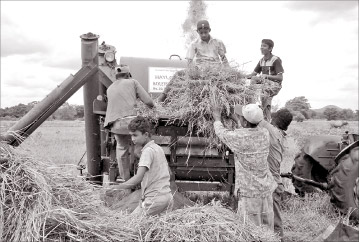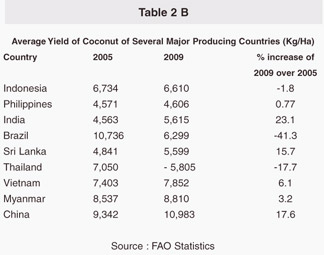|
Domestic agriculture and future challenges - Part II:
The issue of low paddy productivity
One guessestimate puts the average size of holding of paddy land at
two acres that is less than one Hectare, with more than half of the
holdings below 1/4 acre in size; It must be borne in mind that it is not
only those major structural factors which we have discussed above which
contribute to the low level of productivity of Sri Lanka's agriculture,
but also there are several others such as low input, lack of credit,
inadequate extension services, low technology and poor marketing
facilities. But in my view, it is the former which has made the
productivity of her domestic agriculture one of the lowest compared with
the rest of the world. 2003-2005 are the latest years for which
comparable data are available.
 |
|
Paddy
harvesting |
These data also relate to agriculture as a whole but not specifically
to domestic agriculture dominated by rice and coconut, as in Sri Lanka.
Subject to these limitations, these data can be used for comparison
purposes, as in any case the position of domestic agriculture could not
be any better than the position of agriculture as a whole.
Among the 12 selected countries, the level of productivity varies
from US $ 624 in Philippines which is the lowest to more than US $
42,000 in New Zealand, an agricultural country and USA, an industrial
one. While the level of Sri Lanka's agricultural productivity is around
one sixtieth of New Zealand and USA, two developed, high income
countries, all the other countries except Thailand and Philippines have
their respective productivity several fold higher than Sri Lanka.
Still worse is the fact that while the productivity levels in all the
countries have been rising significantly, Sri Lanka's has been rising
marginally by only 3.4 percent in the entire period of 13 years under
comparison. This shows the great potential of productivity enhancement
of Sri Lanka's agriculture, as well as the challenge it is facing in
harnessing that.
Challenges
We have already referred to the low productivity due to limited land
size and non-availability of land due to increasing fragmentation,
insecure land tenure and absence of ownership title for hypothecation
for agricultural credit. There are other less insurmountable problems
facing the domestic agriculture such as;
* Inadequate water for irrigable cultivation,
* Poor quality seed and planting material,
* High prices of fertilizers,
* Inadequate extension services,
* Post-harvest losses,
* Poor marketing facilities,
* Lack of knowledge of, and access to, technology and
* Reluctance of youths to take to farming, particularly the educated.
New push to domestic agriculture
Since the opening of the economy end of 1977, followed up with trade
liberalization and export-led strategy of development, the domestic
agriculture had taken a back seat in the vehicle of Sri Lankan economy.
Domestic agriculture was also not considered a priority candidate in the
governments' plans for export orientation or export diversification.
Even by the end of 2005, nearly three decades later, when the present
government has come in to power, the country has not reached self
-sufficiency in food, except perhaps in the case of rice.
 On the other hand, the global economy has been volatile. World fuel
and food prices have been on the rise. External shocks arising from
these have afflicted developing countries. The government, believing in
the build-up of a strong domestic sector resilient to such external
shocks, as well as taking note of the woes of the farmer community gave
a pivotal place to domestic agriculture, dominated by rice and coconut
and including fishing, livestock and dairy farming, in its development
framework under the Mahinda Chintana- Idiri Dekma (Vision towards a New
Sri Lanka). A large number of measures have been proposed in it, in
order to alleviate the problems of the farmer referred to above. The
following are highlighted: On the other hand, the global economy has been volatile. World fuel
and food prices have been on the rise. External shocks arising from
these have afflicted developing countries. The government, believing in
the build-up of a strong domestic sector resilient to such external
shocks, as well as taking note of the woes of the farmer community gave
a pivotal place to domestic agriculture, dominated by rice and coconut
and including fishing, livestock and dairy farming, in its development
framework under the Mahinda Chintana- Idiri Dekma (Vision towards a New
Sri Lanka). A large number of measures have been proposed in it, in
order to alleviate the problems of the farmer referred to above. The
following are highlighted:
* The restoration of the ancient irrigation system with
rehabilitation of around 10,000 small tanks and implementation of
several multipurpose irrigation schemes;
* Allocation of 100,000 plots of government land to landless farmers,
* Enactment of laws to confer freehold rights of crown lands already
allocated,
* A land titling scheme to provide title to those who possess private
land but without deeds,
* Availability of good quality seeds at cheaper prices,
* Provision of inorganic fertilizer at Rs.350, a tiny fraction of the
market price,
* Easy access to tractors and other agricultural equipment through
cooperative societies,
* Launch of gene-technology and ‘nano’ technology projects throughout
the country,
* Increase in the guagranteed price of paddy for the farmer,
* Resurrection of the Paddy Marketing Board to purchase paddy
directly from the farmer,
* Better storage, packing and marketing facilities to reduce
post-harvest losses,
* Financial assistance to coconut cultivation for drip irrigation,
* Revitalization of sugar factories,
* A guaranteed price for milk,
* Incentives for value addition in milk product,
* Provision of fishing boats at concessionary prices and
* Establishment of fish processing and canning factories.
Innovative phase
No national agricultural policy as such has so far been formulated.
However, the package of action programmes proposed for the domestic
agriculture has given it a new paradigm with new directions. Firstly,
self-sufficiency in food is emphasized but not as the sole objective.
Food self-sufficiency is the production of all the food requirements of
the country locally or within the country. It is not the same thing as
national food security. The latter can be achieved without the former,
if deficiency in domestic production can be filled with foods imported
with available foreign exchange. It would be better, of course, if
national food security could be achieved with self-sufficiency without
having to import foods. But no country, in my view, could be 100 percent
self-sufficient in all the foods it needs. It must be noted also that
going in for self-sufficiency or food security, does not mean that
today's domestic agriculture is intended to remain any longer a
‘subsistence’ agriculture. New domestic agriculture is expected to
create a marketed surplus by value addition to its output, which can
either be exported or converted in to money terms and invested to
develop other sectors.
 Secondly, domestic agriculture is expected to depend on productivity
enhancement, rather than on capital investment, for its growth or
increase in net output. Productivity in Sri Lanka's agriculture, it has
already been stated, is one of the lowest in the world. Secondly, domestic agriculture is expected to depend on productivity
enhancement, rather than on capital investment, for its growth or
increase in net output. Productivity in Sri Lanka's agriculture, it has
already been stated, is one of the lowest in the world.
This is particularly marked in rice/paddy. As shown in Table 2A
except in Pakistan, the yield in Sri Lanka is lower than in the other
selected countries and, in fact, less than half the yield of Egypt and
the United States. The case of coconut is not so bad. As shown in Table
2B, the yield of Vietnam, China and Myanmar are markedly higher but less
than twice as much. There is, however, one salutary feature in both
these cases. The yield has been rising noticeably between 2005 and 2009,
7.1 percent in the case of rice and 15.7 percent in the case of coconut.
We have enumerated earlier the various factors inhibiting
productivity and growth of agriculture. There may be political
compulsions why little can be done in regard to the small size of
existing holdings, but further fragmentation has been ruled out by new
government anti-fragmentation rules and regulations.
The government has also taken several measures to reduce
landlessness. Under the Mahinda Chintana project of giving land to
100,000 farmers, referred to earlier, more than 20,000 allotments have
already been made and permits and documents have been issued for a
further allotment of more than 70,000.
It is also possible, and has been proposed in the Mahinda Chintana:
Vision for the Future, launched in 2010 November, to give free
agricultural land to another 100,000 in the North and the East which
have been freed from the Tiger terrorists in May 2009.
There is also a proposal here to offer 5,000 hectares of new land
under the Moragahakanda and Kukulu Ganga Development Projects.
To be continued
|



